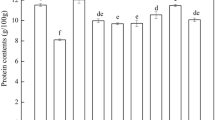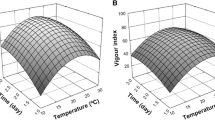Abstract
The roasting treatment has been used to extend the shelf life of food and improves its quality, and eliminate or reduce toxic. In this study, we investigate the changes in the physicochemical properties and antioxidant activities of Ginkgo biloba seeds (GBS) according to the roasting temperature and duration. As the roasting temperature and duration increased, the pH (from 7.32 to 6.31) and total cyanide content (from 1.49 to 0.70 µg/g) decreased, whereas the titratable acidity (from 0.39 to 0.84%) increased. The antioxidant activities increased rapidly at 210 °C according to the increase in the roasting temperature and duration. The 4′-O-methylpyridoxine (MPN) content in the 210 °C heat treatment group decreased by more than 70% compared to the MPN content in the control group. These results suggest that heat-treated GBS could be used in food materials and medicines for decreasing cyanide and MPN contents as well as for increasing antioxidant compound contents.


Similar content being viewed by others
Change history
25 September 2018
Unfortunately, first author Heung-Bin Lim’s affiliation was missed to include in the original version of this article. The affiliation of Heung-Bin Lim should be: Industrial Crop Science and Technology, Chungbuk National University, Cheongju, Chungbuk, 28644, Korea.
Abbreviations
- GBS:
-
Ginkgo biloba seeds
- MPN:
-
4′-O-methylpyridoxine
- DPPH:
-
2,2-Diphenyl-1-picrylhydrazyl
- ABTS:
-
2,2′-Azino-bis-(2-ethylbenzothiazoline-6-sulfonate)
- HPLC:
-
High performance liquid chromatography
- AEAC:
-
l-Ascorbic acid equivalent antioxidant capacity
References
Choi Y, Lee SM, Chun J, Lee HB, Lee J. Influence of heat treatment on the antioxidant activities and polyphenolic compounds of shiitake (Lentinus edodes) mushroom. Food Chem. 99: 381–387 (2006)
Wandsnider L. The roasted and the boiled: food composition and heat treatment with special emphasis on pitheaith cooking. J. Anthropol. Archaeol. 16: 1–48 (1997)
Chan PC, Xia Q, Fu PP. Ginkgo Biloba leave extract: biological, medicinal, and toxicological effects. J. Environ. Sci. Health C Environ. Carcinog. Ecotoxicol Rev. 25: 211–244 (2007)
Kleijnen J, Knipschild P. Ginkgo biloba. Lancet 340: 1136–1139 (1992)
Wada K, Ishigaki S, Ueda K, Sakata M, Haga M. An antivitamin B6, 4′-methoxypyridoxine from the seed of Ginkgo biloba L. Chem. Pharm. Bull. 33: 3555–3557 (1985)
Leistner E, Drewke C. Ginkgo biloba and Ginkgotoxin. J. Nat. Prod. 73: 86–92 (2010)
Tommasi F, Paciolla C, de pinto MC, De Gara L. Effects of storage temperature on viability, germination and antioxidant metabolism in Ginkgo biloba L. seeds. Plant Physiol. Biochem. 44: 359–368 (2006)
Park SB, Cho GS. Antimicrobial activity of extracts and fractions of Ginkgo biloba leaves, seed and outer seedcoat. J Korean Soc Food Sci Nutr 40: 7–13 (2011)
Tredici PD. Ginkgos and people - a thousand years of interaction. Arnoldia 51: 2–15 (1991)
Deng Q, Wang L, Wei F, B Xie, F Huang, W Huang, J Shi, Q Huang, B Tian, S Xue. Functional properties of protein isolates, globulin and albumin extracted from Ginkgo biloba seeds. Food Chem. 124: 1458–1465 (2011)
Jinap S, Wan Rosli WR, Russly AR, Nordin LM. Effect of roasting time and temperature on volatile component profiles during nib roasting of cocoa beans (Theobroma cacao). J. Sci. Food Agric. 77: 441–448 (1998)
AOAC. Official Methods of Analysis. 17th ed. Method 934.01. Association of Official Analytical Communities, Gaithersburg, MD, USA (2006)
AOAC. Official Methods of Analysis. 14th ed. Method 942.15. Association of Official Analytical Communities, Arlington, VA, USA (1984)
Epstein J. Estimation of microquantities of cyanide. Anal. Chem. 19: 272–274 (1947)
Singleton VL, Rossi JA Jr. Colorimetry of total phemolics with phosphomolybdic–phosphotungstic acid reagent. Am. J. Enol. Viticult. 16: 144–158 (1965)
Ouchemoukh S, Hachoud S, Boudraham H, Mokrani A, Louaileche H. Antioxidant activities of some dried fruits consumed in Algeria. LWT-Food Sci. Technol. 49: 329–332 (2012)
Al ML, Dezmirean D, Adela M, Otilia B, Laslo L, Bogdanov S. Physicochemical and bioactive properties of different floral origin honeys from Romania. Food Chem. 112: 863–867 (2009)
Re R, Pellegrini N, Proteggente A, Pannala A, Yang M, Rice-Evans C. Antioxidant activity applying an improved ABTS radical cation decolorization assay. Free Radic. Biol. Med. 26: 1231–1237 (1999)
Suh JH, Yang DH, Lee BK, Eom HY, Kim UY, Kim JH, Lee HY, Han SB. Simultaneous determination of B group vitamins in supplemented food products by high performance liquid chromatography-diode array detection. Bull Korean Chem. Soc. 32: 2648–2656 (2011)
Emily LB, Terri DB, Lester AW. Effect of cultivar and roasting method on composition of roasted soybeans. J. Sci. Food Agric. 89: 821–826 (2009)
Yoon SK, Kim WJ. Effects of roasting conditions on quality and yields of barley tea. Korean J Food Sci Technol 21: 575–582 (1987).
Bae KM, Park SH, Jung KH, Kim MJ, Hong SH, Song YO, Lee HS. Effects of roasting conditions on physicochemical properties and sensory properties of Liriopis Tuber. J Korean Soc Food Sci Nutr 39: 1503–1508 (2010)
Żyżelewicz D, Budryn G, Krysiak W, Oracz J, Nebesny E, Bojczuk M. Influence of roasting conditions on fatty acid composition and oxidative changes of cocoa butter extracted from cocoa bean of Forastero variety cultivated in Togo. Food Res. Int. 63: 328–343 (2014)
Saunders J, Jervis F. The role of buffer salts in non-enzymatic browning. J. Sci. Food Agric. 17: 245–249 (1966)
Wood LA, Shouse PJ. Standard reference materials: Use of standard light-sensitive paper for calibrating carbon arcs used in testing textiles for colorfastness to light (Special Publication 260-41). National Bureau of Standards, Washington, DC, USA, pp. 1–24 (1972)
Shakerardekani A, Karim R, Ghazali HM, Chin NL. Effect of roasting conditions on hardness, moisture content and colour of pistachio kernels. International Food Research journal 18: 723–729 (2011)
Hodge JE. Dehydrated foods: chemistry of browning reactions in model systems. J. Agric. Food Chem. 1: 928–943 (1953)
Ahmed SB, Mahgoub SA, babiker BE. Changes in tannin and cyanide contents and diastic activity during germination and the effect of traditional processing on cyanide content of sorghum cultivars. Food Chem. 56: 159–162 (1996)
Cardoso AP, Mirione E, Ernesto M, Massaza F, Cliff J, Haque MR, Bradbury JH. Processing of cassava roots to remove cyanogens. J. Food Compost. Anal. 18: 451–460 (2005)
Cho HJ, Do BK, Shlm SM, Kwon HJ, Lee DH, Nah AH, Chol YJ, Lee SY. Determination of cyanogenic compounds in edible plants by ion chromatography. Toxicol. Res. 29: 143–147 (2013)
Mikašauskaitė J, Ragažinskienė O, Maruška A. Variation of total amount of phenolic compounds, radical scavenging activity and volatile com pounds of Liriodendron tulipifera L. and Ginkgo biloba L. leaves extracts during different vegetation periods. Biologija 59: 175–186 (2013)
Ellnain-Wojtaszek M. Phenolic acids from Ginkgo biloba L. Part I. Qualitative analysis of free and liberated by hydrolysis phenolic acids. Acta Pol. Pharm. 54: 225–228 (1997)
Xu B. and Chang SKC. Total phenolic, phenolic acid, anthocyanin, flavan-3-ol, and flavonol profiles and antioxidant properties of pinto and black beans (Phaseolus vulgaris L.) as affected by thermal processing. J. Agric. Food Chem. 57: 4754–4764 (2009)
Yoshino M, Murakami K. Interaction of iron with polyphenolic compounds, application to antioxidant characterization. Anal. Biochem. 257: 40–44 (1998)
Terpinc P, Polak T, Poklar N, Ulrih NP, Abramovic H. Effect of heat treatment of camelina (Camelina sativa) seeds on the antioxidant potential of their extracts. Food Chem. 97: 472–479 (2006)
Yoshimura T, Udaka N, Morita J, Jinyu Z, Sasaki K, Kobayashi D, Wada K, Hori Y. High performance liquid chromatographic determination of ginkgotoxin and ginkgotoxin‐5′‐Glucoside in Ginkgo biloba seeds. J. Liq. Chromatogr. Related Technol. 29: 605–616 (2016)
Kobayashi, D, Yoshimura T, Johno A, Sasaki K, Wada K. Toxicity of 4′-O-methylpyridoxine-5′-glucoside in Ginkgo biloba seeds. Food Chem. 126: 1198–1202 (2011)
Fiehe K. Arenz A, Drewke C, Hemscheidt T, Williamson RT, Leistner E. Biosynthesis of 4′-O-methylpyridoxine (Ginkgotoxin) from primary precursors. J. Nat. Prod. 63: 185–189 (2000)
Acknowledgements
This research was supported by Basic Science Research Program through the National Research Foundation of Korea (NRF) funded by the Ministry of Education (Grant No. NRF-2017R1A6A3A11034208).
Author information
Authors and Affiliations
Corresponding author
Rights and permissions
About this article
Cite this article
Lim, HB., Kim, DH. Effects of roasting conditions on physicochemical properties and antioxidant activities in Ginkgo biloba seeds. Food Sci Biotechnol 27, 1057–1066 (2018). https://doi.org/10.1007/s10068-018-0348-7
Received:
Revised:
Accepted:
Published:
Issue Date:
DOI: https://doi.org/10.1007/s10068-018-0348-7




